Related Research Articles

George Montagu was an English army officer and naturalist. He was known for his pioneering Ornithological Dictionary of 1802, which for the first time accurately defined the status of Britain's birds. He is remembered today for species such as the Montagu's harrier, named for him.

Rhagonycha is a genus of soldier beetle belonging to the family Cantharidae. There are at least 140 described species recorded from Europe, North America and Japan, and thought to date from the Upper Eocene to recent periods.

Giuseppe De Cristoforis was an Italian naturalist and collector.
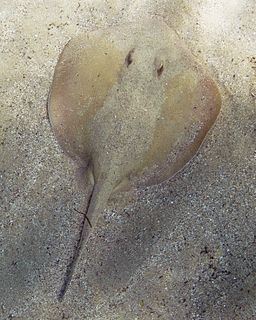
The common stingaree is a species of stingray in the family Urolophidae. The most abundant ray in inshore waters off eastern Australia, it generally inhabits estuaries, sandy flats, and rocky reefs from the shore to a depth of 60 m (200 ft). This plain brownish to grayish species has a rounded pectoral fin disc with a broadly triangular snout. Its nostrils have enlarged lobes on their outer margins and a skirt-shaped curtain of skin with a fringed posterior margin between them. Its tail bears a small dorsal fin before the stinging spine, and terminates in a leaf-shaped caudal fin. This ray can grow to 52 cm (20 in) long.

Giuseppe Saverio Poli was an Italian physicist, biologist and natural historian.
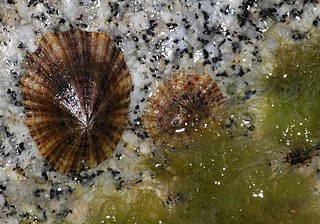
Patella caerulea, is a species of limpet in the family Patellidae. It is known by the common names Mediterranean limpet and rayed Mediterranean limpet. It is native to the Mediterranean Sea.
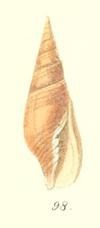
Strigatella testacea is a species of sea snail, a marine gastropod mollusk in the family Mitridae, the miters or miter snails.
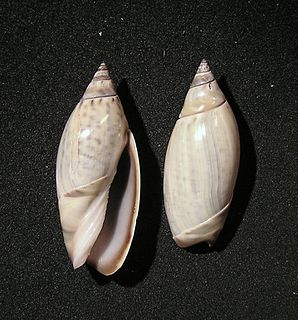
Agaronia testacea, common name the Panama false olive, is a species of sea snail, a marine gastropod mollusk in the family Olividae, the olives.

Agaronia is a genus of sea snails, marine gastropod mollusks in the family Olividae.
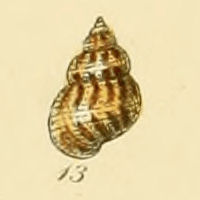
Alvania punctura is a species of minute sea snail, a marine gastropod mollusk or micromollusk in the family Rissoidae.

Phorcus turbinatus, common name the turbinate monodont, is a species of sea snail, a marine gastropod mollusk in the family Trochidae, the top snails.
Eupterote translata is a moth in the family Eupterotidae. It was described by Charles Swinhoe in 1885. It is found in India.

Lagena is a genus of foraminifera in the superfamily Nodosariacea.
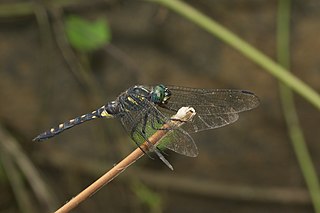
Onychothemis testacea, Stellate river hawk, riverhawker, is a species of dragonfly in the family Libellulidae. It is widespread in many Asian countries.

Mycophaga testacea is a species of fly in the family Anthomyiidae. It is found in the Palearctic. For identification see
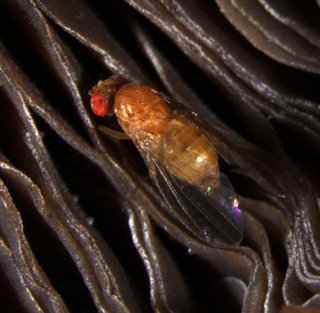
Drosophila neotestacea is a member of the Testacea species group of Drosophila. Testacea species are specialist fruit flies that breed on the fruiting bodies of mushrooms. These flies will choose to breed on psychoactive mushrooms such as the Fly Agaric Amanita muscaria. Drosophila neotestacea can be found in temperate regions of North America, ranging from the north eastern United States to western Canada.

Drosophila testacea is a member of the Testacea species group of Drosophila. Testacea species are specialist fruit flies that breed on the fruiting bodies of mushrooms. Drosophila testacea can be found in temperate regions of Europe, extending to east Asia. Drosophila testacea and Drosophila orientacea can produce viable hybrids, though they are separated by geography and behavioural barriers. Drosophila testacea females will also readily mate with Drosophila neotestacea males, but viable hybrids are never produced. This hybrid inviability ) may be due to selfish X chromosomes and co-evolved suppressors. Alternately, differences in sex pheromone reception could underlie female readiness and male willingness to copulate.
Drosophila orientacea is a member of the Testacea species group of Drosophila. Testacea species are specialist fruit flies that breed on the fruiting bodies of mushrooms. Drosophila orientacea is found in northern Japan on the island of Hokkaido. However, the European species Drosophila testacea and D. orientacea can produce viable hybrids, blurring the level of speciation between the two species. While viable hybrids are produced, extreme behavioural barriers likely prevent mating in the wild. While D. orientacea readily mates with Drosophila neotestacea, viable hybrids are never produced. This hybrid inviability ) may be due either to issues during copulation, or selfish X chromosomes and co-evolved suppressors.
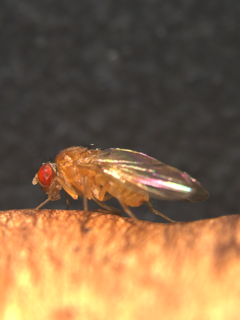
The Drosophila testacea species group belongs to the Immigrans-tripunctata radiation of the subgenus Drosophila, and contains 4 species: Drosophila putrida, Drosophila neotestacea, Drosophila testacea, and Drosophila orientacea. Testacea species are specialist mushroom-feeding flies, and can metabolize toxic compounds in Amanita mushrooms. The Testacea species group is studied for its specialist ecology, population genetics, and bacterial endosymbionts. The North American species Drosophila neotestacea is perhaps the best-studied of the group for its interactions with parasitic wasps and nematodes, bacterial endosymbionts, and trypanosomatid parasites. Of note, selfish X chromosomes have been discovered in three of the four Testacea group species.
References
- ↑ Beccaloni, G.; Scoble, M.; Kitching, I.; Simonsen, T.; Robinson, G.; Pitkin, B.; Hine, A.; Lyal, C., eds. (2003). "Delphyre testacea". The Global Lepidoptera Names Index . Natural History Museum . Retrieved April 21, 2018.
| This Euchromiina-related article is a stub. You can help Wikipedia by expanding it. |